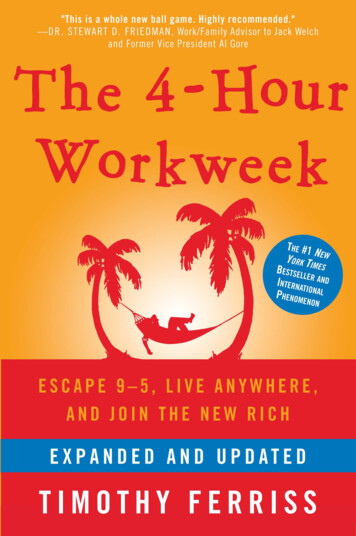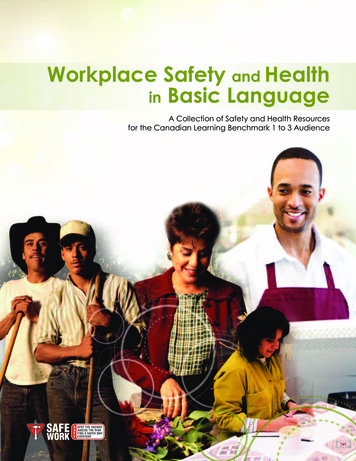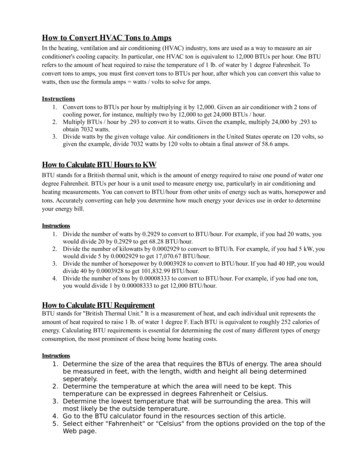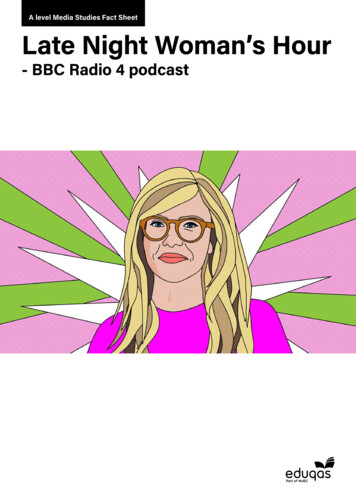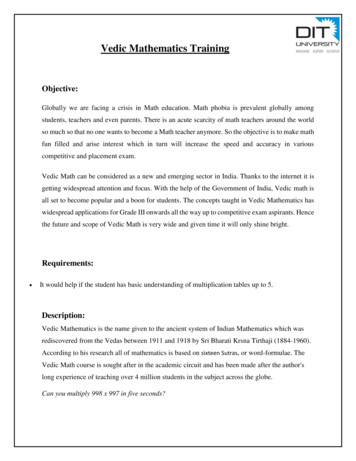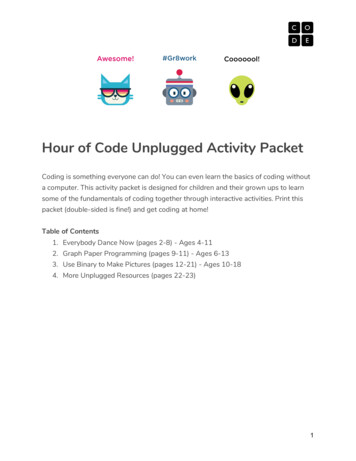
Transcription
Hour of Code Unplugged Activity PacketCoding is something everyone can do! You can even learn the basics of coding withouta computer. This activity packet is designed for children and their grown ups to learnsome of the fundamentals of coding together through interactive activities. Print thispacket (double-sided is fine!) and get coding at home!Table of Contents1. Everybody Dance Now (pages 2-8) - Ages 4-112. Graph Paper Programming (pages 9-11) - Ages 6-133. Use Binary to Make Pictures (pages 12-21) - Ages 10-184. More Unplugged Resources (pages 22-23)1
Everybody Dance NowAges: 4-11 years oldLesson Objectives: Students will recognize actions of the choreographer as signals to initiate acommand.------------------------- Lesson Guide -----------------------------1. Description: Programmers use “events” to change the way a program respondsto a user’s actions, like the push of a button or the click of a mouse. When youtouch the screen on your tablet to scroll, that’s an event. When you press abutton on your controller to play a video game, that button press is an event, too!For this lesson, you’ll use a paper controller to choreograph a dance for yourfamily member.2. Vocabulary: Read this vocabulary card together.3. Activitya. Make connections: Ask your child “Where else have you seen “events”that give signals in the real world?i.What about something like something like a dance? How dodancers know when to do a certain move?b. Let’s learn some dance moves so we can program a new dance together!2
The Star Step 1: Start by standing up straight with your arms by yourside. Step 2: Kick your right leg out and put both arms in the air tomake your body look like a star. Step 3: C ome back to standing position. Step 4: K ick your left leg out and put both arms in the air. Step 5: R epeat!3
The High Clap Step 1: S tart by standing up straight with your arms by yourside. Step 2: Clap your hands to the right, above your head. Step 3: C ome back to standing position. Step 4: C lap your hands to the left, above your head. Step 5: Repeat! (Bonus: try moving your hips to the side thatyou’re clapping on)4
The Dab Step 1: Start by standing up straight with your arms by yourside. Step 2: Drop your head into the bent crook of a slanted,upwardly angled arm while raising the opposite arm straight in aparallel direction (see image above). Step 3: Repeat! (Bonus: Lift a knee up while dabbing)5
The This or That Step 1: S tart by standing up straight with your arms by yourside. Step 2: Raise your right hand like you’re a waiter holding a trayand tilt your head towards it. Step 3: Come back to standing position. Step 4: Raise your left hand like you’re a waiter holding a trayand tilt your head towards it. Step 5: R epeat!6
The Body Roll Step 1: Start by standing up straight with your arms by yourside. Step 2: Bend your knees and snake your body to the right,moving your head first and then your hips in one direction. Step 3: R epeat!7
Activity Continued: Choose one choreographer and a dancer (or many dancers). Whenever the choreographer touches a button, the dancers will do thecorresponding dance. As a reminder: Star is the Star Dance Triangle is the Dab Hexagon is the High Clap Circle is the Body Roll Rectangle is the This or That Turn on your favorite song and hit the dance floor!8
Graph Paper ProgrammingAges: 6-13 years oldLesson Objective: S tudents will be able to reframe a sequence of steps as an encoded program.------------------------- Lesson Guide -----------------------------1. Description: By "programming" one another to draw pictures, you and your childwill get an opportunity to experience some of the core concepts of programmingin a fun and accessible way. Your child will use symbols to instruct you to colorsquares on graph paper to reproduce an existing picture.2. Introduce the Topic: Ask your child, how do robots know how to do the thingsthey do? Do they have brains that work the same way that ours do?a. The goal of this quick discussion is to call out that while robots may seemto behave like people, they're actually responding to their programming.3. Practice Together: In this activity, students will act as both programmers androbots, coloring in squares according to programs that they have written for you.Say to your child:a. Today, you’re going to get to program a robot Me! You’ll write programsusing symbols with special meanings to help me recreate a picture.b. These are the only instructions that I understand.i.ii.iii.iv.v.Move one square rightMove one square leftMove one square upMove one square downFill in square with colorLet’s practice! Here is an image. Pretendthat I am the drawing robot.Starting at the star, tell me instructions torecreate the image to the left.9
c. You just gave me a list of steps to finish a task. In programming, that’scalled an algorithm. Great work! Hmm, but what happens when we wantto write down the algorithm for a drawing like this?i.What would the code sound like to recreate this picture?ii.What if you had to write it all out? Is there an easier way thanwriting all the words?d. Show your child this list of symbols:e. Discuss: How could we use these symbols to make our instructionseasier?f. Look at the sample solution using symbols below and discuss the benefitsof using symbols shorthand.10
Now you try!Choose one person to be Partner A and another person to be Partner B.Partner A, choose one of the images below. Don’t let your partner know which one you pick!Image 1Image 2Image 31) P artner A, write a program.(Use )Image 4Image 5Image 63) Partner B, draw your partner’s program:Step 1234567891011121314151617182) G ive your program to your partner.Switch!1)1) Partner B, write a program.(Use )3) Partner A, draw your partner’s program:Step 1234567891011121314151617182) Give your program to your partner.11
Use Binary to Make PicturesAges: 1 0-18 years oldLesson Objective: S tudents will learn how to use binary to represent colors and images.----------------------------- Lesson Guide----------------------------Description: We’re going to look at one way that Binary can be used to represent ColorImages and you’ll be creating your own P ixel Art.In this activity, we’ll use binary codingto represent pathways through aseries of “high” and “low” choices. Forexample, to the right are a group ofcolors at the tail-ends of a smalltree-like diagram. Starting from theleft, we can c hoose a color by using asequence of High & Low decisions tomove from left-to-right and ultimatelyend at a color.For example, the color Orange wouldbe “High Low Low”.Check Yourself:1. How would you represent the color Pink ?2. What color does this represent: L ow Low High ?(The answers are on the last page of this activity.)12
Hey! We Can Use Binary For This!A 0 will represent a L ow / Down choice and a 1 will represent a High / Up choice. Forexample: the binary number 1001 could be read as “High Low Low High”Using the same color map from before, we can use a binary number to represent acolor . For example, the number 0 10 represents the c olor g reenNow You Try!1. Use this chart to determine what color would be coded by the number 1 11 .2. Use the chart to determine what binary number would represent the color orange.(The answers are on the last page of this activity.)13
Representing Multiple ColorsI f we wanted to represent a s equence of colors, we can write a sequence of binarynumbers to represent those colors. Here’s an example:101011110000This longer binary number secretly represents 4 different colors . We can see eachindividual color by breaking this number up into c hunks of 3 :101011110000 1 01 011 1 10 000Each chunk represents a single color. We can use the same chart to figure outeach of these individual colors:101 Red011 Yellow110 Pink000 PurpleSo the n umber 101011110000 represents the colors R ed Yellow Pink PurpleNow You Try!1. What colors are represented by 1 10011010 (hint: 3 colors)2. What binary sequence represents Blue Orange Black ? (hint: 9 digits)14
An Introduction to PixelsMost electronics like smartphones, computers, and television screens are made ofmillions of tiny pieces called pixels . Each pixel is like a tiny little box on your screen thatis used to represent the images we see. Usually the pixels are so s mall that we don’teven notice the boxes, but when we zoom-in we start to see them more clearly.Source: csunplugged.orgOur electronic devices use binary signals to determine what types of images to createusing these pixels using the following steps: They receive a b inary sequence They decode the sequence to determine what colors the sequence represents Each color represents a certain pixel . The computer draws that color in theappropriate boxFor Example:15
You Try!Use colored pencils / markers / post-its / crayons / etc to draw in the colors for each ofthe grids below. Use this n ew choice-map to determine which colors to use. Theanswers are on the next page for you to check when you’re done.100111001110101011100010001(Color This In!)100001100001100001100001100(Color This In!)16
More Practice Drawing Pictures with BinaryBinary Encoding for 10x10 image111 111 000 000 111 111 000 000 111 111111 000 100 100 000 000 001 001 000 111000 100 100 010 010 001 001 110 110 000000 100 010 010 001 001 110 110 101 000000 010 010 001 001 110 110 101 101 000000 010 001 001 110 110 101 101 011 000111 000 001 110 110 101 101 011 000 111111 111 000 110 101 101 011 000 111 111111 111 111 000 101 011 000 111 111 111111 111 111 111 000 000 111 111 111 11117
Binary Encoding for 10x10 image111 111 000 000 111 111 000 000 111 111111 000 100 100 000 000 001 001 000 111000 100 100 010 010 001 001 110 110 000000 100 010 010 001 001 110 110 101 000000 010 010 001 001 110 110 101 101 000000 010 001 001 110 110 101 101 011 000111 000 001 110 110 101 101 011 000 111111 111 000 110 101 101 011 000 111 111111 111 111 000 101 011 000 111 111 111111 111 111 111 000 000 111 111 111 11118
Binary Encoding for 8x8 image000 111 111 111 111 111 110 110000 000 000 010 010 100 110 110001 000 010 010 010 100 100 100001 001 001 001 101 101 101 100110 011 011 011 111 111 101 101110 011 001 011 010 111 111 000110 110 001 010 010 010 111 000110 001 001 001 010 000 000 00019
Binary Encoding for 8x8 image000 111 111 111 111 111 110 110000 000 000 010 010 100 110 110001 000 010 010 010 100 100 100001 001 001 001 101 101 101 100110 011 011 011 111 111 101 101110 011 001 011 010 111 111 000110 110 001 010 010 010 111 000110 001 001 001 010 000 000 00020
AnswersPage 121. Pink would be “Up Up Down”2. Low Low High would be “Blue”Page 131. 111 represents “Up Up Up” which is the color b lack2. Orange is “Up Down Down” which is the number 100Page 141. 110011010 110 011 010 Pink Yellow Green2. Blue Orange Black 001 100 111 001100111Page lueRedBlueRedBlueRedBlueRedUsing binary numbers to represent Pixels, we can make some really creative designs. Inthe next few pages, you’ll have a chance to create some of these Pixel Art designs.21
More Unplugged ResourcesThese lessons were designed for classroom use for teachers and students, but they’re easilysuited for at-home learning.DescriptionURLSecret cingAge Group 4-11yrsQR CodeIn this lesson, students develop theirown secret handshake sequencesusing three or more moves. Theyrecord their sequences with symbolsand revise them based on challengecriteria.What is a 4/Age Group: 4-11yrsIn this activity students develop apreliminary definition of a computerthrough brainstorming ideas andsorting pictures into “is a computer”and “is not a computer” categories.My Robotic ge Group: 7-11yrsUsing a predefined “RobotVocabulary” your student will figureout how to guide you to accomplishspecific tasks without discussingthem first. This segment teachesstudents the connection betweensymbols and actions, as well as thevaluable skill of debugging.22
Representing Age Group: 7-11yrsIn this lesson, students learn aboutthe binary number system. With aset of cards that represent the placevalues in a binary (base-2) numbersystem by a collection of dots,students turn bits "on" or "off" byturning cards face up and facedown, then observe the numbersthat result from these differentpatterns.Paper AIAge Group: ntro/ai/unpluggedPlay a game that they are probablyall so familiar with that they mayhave stopped playing it altogetherbecause it’s not a challengeanymore. It’s Tic-Tac-Toe!Will it ge Group: 11-18yrsStudents trace simple robotprograms on paper to develop asense of how to read and reasonabout code with if statements in it.Students also try their hand atwriting code by hand to handle arobot situation.23
Hour of Code Unplugged Activity Packet Coding is something everyone can do! You can even learn the basics of coding without a computer. This activity pac




